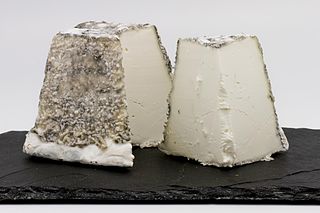
Colby is a semihard orange cheese made from cow's milk. It is named after the city of Colby, Wisconsin, USA, where it was first developed in 1885 and quickly became popular.

Gubbeen Cheese is a surface ripened, semi-soft, cow's milk cheese with a pink and white rind. The flavours are creamy with mushroom and nutty aftertastes but vary depending on maturity of cheese. Gubbeen Farmhouse Products also produce a Smoked Gubbeen.

There are many different types of cheese. Cheeses can be grouped or classified according to criteria such as length of fermentation, texture, methods of production, fat content, animal milk, and country or region of origin. The method most commonly and traditionally used is based on moisture content, which is then further narrowed down by fat content and curing or ripening methods. The criteria may either be used singly or in combination, with no single method being universally used.

Cheese ripening, alternatively cheese maturation or affinage, is a process in cheesemaking. It is responsible for the distinct flavour of cheese, and through the modification of "ripening agents", determines the features that define many different varieties of cheeses, such as taste, texture, and body. The process is "characterized by a series of complex physical, chemical and microbiological changes" that incorporates the agents of "bacteria and enzymes of the milk, lactic culture, rennet, lipases, added moulds or yeasts, and environmental contaminants". The majority of cheese is ripened, except for fresh cheese.
Agrococcus is a genus in the phylum Actinomycetota (Bacteria).

Rumi cheese is one of the main types of cheese in Egypt. Despite its name, the cheese is Egyptian. Traces of it go back to the ancient Egyptians. It has a pungent smell, and different degrees of saltiness depending on the age.

Formai de Mut dell'Alta Valle Brembana is an Italian cheese prepared from raw cow's milk that originated in Lombardy, Italy. It is prepared in a similar manner to Fontina d'Aosta cheese at Alta Valle Brembana in high pasture lands and in Bergamo, Lombardy. It is rarely found outside of Lombardy, and it is produced in "very limited quantities". It was classified with a protected designation of origin status in 1996.
Microbacterium aoyamense is a Gram-positive and non-motile bacterium from the genus Microbacterium which has been isolated from soil from Tokyo in Japan.
Microbacterium azadirachtae is a Gram-positive, non-spore-forming and motile bacterium from the genus Microbacterium which has been isolated from the rhizoplane of the plant Azadirachta indica from the Botanical Garden of Coimbatore in India. Microbacterium azadirachtae can promote plant growth by producing phytohormones.
Microbacterium barkeri is a bacterium from the genus Microbacterium which has been isolated from domestic sewage and from smear from a cheeses. Microbacterium barkeri has the ability to degrade polyvinyl alcohol.
Microbacterium binotii is a Gram-positive, rod-shaped and non-spore-forming bacterium from the genus Microbacterium which has been isolated from human blood from Foch Hospital in Suresnes, France.
Microbacterium deminutum is a Gram-positive and non-motile bacterium from the genus Microbacterium.
Microbacterium foliorum is a bacterium from the genus Microbacterium which has been isolated from the phyllosphere of grasses in Germany.
Microbacterium halotolerans is a Gram-positive, halophilic aerobic, non-spore-forming and non-motile bacterium from the genus Microbacterium which has been isolated from hypersaline soil in China.
Microbacterium kitamiense is a heterotrophic, strictly aerobic, mesophilic and non-motile bacterium from the genus Microbacterium which has been isolated from waste water from a sugar-beet factory in Kitami in Japan. Microbacterium kitamiense produces polysaccharide. Microbacterium kitamiense has a high GC-content.
Microbacterium oxydans is a Gram-positive bacterium from the genus Microbacterium which occurs in human clinical specimens. Microbacterium oxydans has the ability to degrade alginate and laminarin.
Microbacterium paludicola is a Gram-positive, xylanolytic, short-rod-shaped and non-motile bacterium from the genus Microbacterium which has been isolated from swamp forest soil from Ulsan, Korea.
Microbacterium resistens is a bacterium from the genus Microbacterium which has been isolated from a corneal ulcer in Zürich, Switzerland.
Microbacterium xylanilyticum is a Gram-positive, non-spore-forming, xylan-degrading and non-motile bacterium from the genus Microbacterium which has been isolated from sludge in Cheongju in Korea.
Agrococcus casei is a Gram-positive bacterium from the genus Agrococcus which has been isolated from the surfaces of smear-ripened cheese.






